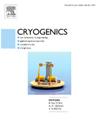用于间接冷却超导磁体的低温热虹吸管
IF 1.8
3区 工程技术
Q3 PHYSICS, APPLIED
引用次数: 0
摘要
热虹吸管是一种热力学现象,完全依靠重力和相变促进冷却系统内的低温循环。这种机制利用整个冷却回路中低温流体密度的变化,形成压力梯度。这种梯度是低温液体循环的主要驱动力。为了消除循环泵的必要性,确定冷却回路的几何形状、热虹吸管的配置、高度以及低温相分离器的垂直位置至关重要。本文介绍了一个简化的计算模型,以及超导磁体间接冷却回路两种不同配置的低温热虹吸管的几何计算。本文章由计算机程序翻译,如有差异,请以英文原文为准。
Cryogenic thermosiphon used for indirect cooling of superconducting magnets
A thermosiphon is a thermodynamic phenomenon that facilitates the circulation of cryogen within a cooling system, relying solely on gravitational forces and phase change. This mechanism leverages the variations in the density of the cryogenic fluid throughout the entire cooling loop, creating a pressure gradient. This gradient serves as the primary driving force for the circulation of the cryogen. To negate the necessity of a circulation pump, it is crucial to determine the geometry of the cooling loop, the configuration of the thermosiphon, its height, and the vertical placement of the cryogen phase separator. This paper introduces a simplified computational model and the geometric calculations of the cryogenic thermosiphon for two distinct configurations of the indirect cooling loop for superconducting magnets.
求助全文
通过发布文献求助,成功后即可免费获取论文全文。
去求助
来源期刊

Cryogenics
物理-热力学
CiteScore
3.80
自引率
9.50%
发文量
0
审稿时长
2.1 months
期刊介绍:
Cryogenics is the world''s leading journal focusing on all aspects of cryoengineering and cryogenics. Papers published in Cryogenics cover a wide variety of subjects in low temperature engineering and research. Among the areas covered are:
- Applications of superconductivity: magnets, electronics, devices
- Superconductors and their properties
- Properties of materials: metals, alloys, composites, polymers, insulations
- New applications of cryogenic technology to processes, devices, machinery
- Refrigeration and liquefaction technology
- Thermodynamics
- Fluid properties and fluid mechanics
- Heat transfer
- Thermometry and measurement science
- Cryogenics in medicine
- Cryoelectronics
 求助内容:
求助内容: 应助结果提醒方式:
应助结果提醒方式:


